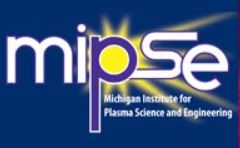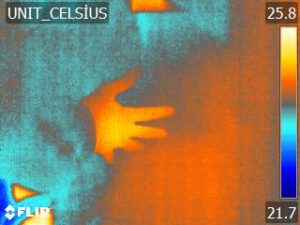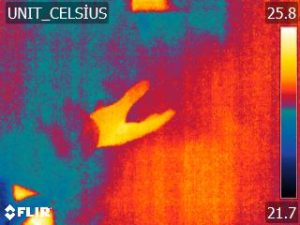 Dr. Mikhail Shneider was looking for an alternative answer to this question: can plasma generated at air-liquid interface be used to modify cell biology? His research is focused on osmosis – diffusion of water – in cell environment activated by a non-equilibrium plasma source. He studied ion movements due to electric field in the concept of electro-osmosis and emphasized that hydrated ions with a water shell around become larger in size and slower in mobility. The varying dimensions and time scales can be utilized for the selectivity of cell membrane. The osmotic pressure outside cells can be controlled by plasma and be adjusted to damage cell membrane. Additionally, air or oxygen plasma-treated water becomes acidic and disrupts the outer walls of bacteria and viruses. He specifically underlined that osmotic pressure cannot be the only mechanism destroying cells; however, its role cannot be studied in detail yet.
Dr. Mikhail Shneider was looking for an alternative answer to this question: can plasma generated at air-liquid interface be used to modify cell biology? His research is focused on osmosis – diffusion of water – in cell environment activated by a non-equilibrium plasma source. He studied ion movements due to electric field in the concept of electro-osmosis and emphasized that hydrated ions with a water shell around become larger in size and slower in mobility. The varying dimensions and time scales can be utilized for the selectivity of cell membrane. The osmotic pressure outside cells can be controlled by plasma and be adjusted to damage cell membrane. Additionally, air or oxygen plasma-treated water becomes acidic and disrupts the outer walls of bacteria and viruses. He specifically underlined that osmotic pressure cannot be the only mechanism destroying cells; however, its role cannot be studied in detail yet.
Tag: Plasma Applications
Development of a small-scale helical surface dielectric barrier discharge for characterizing plasma-surface interfaces
Understanding plasma-surface interactions is important in a variety of emerging research areas, including sustainable energy, environmental remediation, medicine, and high-value
manufacturing. Plasma-based technologies in these applications utilize surface chemistry driven by species created in the plasma or at a plasma-surface interface. Here, we develop a helical dielectric barrier discharge (DBD) configuration to produce a small-scale plasma that can be implemented in a diffuse reflectance infrared Fourier transform spectroscopy (DRIFTS) cell and integrated with a commercial Fourier transform infrared (FTIR) spectrometer instrument to study plasma interactions with inert or catalytic solid media. The design utilizes the entire surface of a cylinder as its dielectric, enhancing the plasma contact area with a packed bed. In this study, we characterize the electrical and visual properties of the helical DBD design in an empty reaction cell and with added potassium bromide (KBr) powder packing material in both air and argon gas environments at ambient conditions. The new surface DBD configuration was integrated into a DRIFTS cell and the time evolution of water desorbing from the KBr packed bed was investigated. Measurements show that this configuration can be operated in filamentary or glow-like mode depending on the gas composition and the water content absorbed on KBr solid media. These results not only set the basis for the study of plasma-surface interactions using a commercial FTIR, but also show that controlling the gas environment and water content in a packed bed might be useful for studying different plasma regimes that are typically not possible at atmospheric pressure.
You can reach the paper via this link: Nazli Turan et al 2020 J. Phys. D: Appl. Phys
Plasma meets with Kapton surface
Dielectric barrier discharges are a type of AC plasmas aiming to limit current in time to prevent spark formation. The dielectric layer holds charges, instead of letting them flow as in conductive materials. The constant exposure to plasma species causes wear/deformation on the surface. Here I show an example of Kapton layer.
Art of thermal radiation
If you have materials opaque to IR, you can create some illusions! You can take photo of yourself from the back of the thermal camera! Or, just play with the color scheme 🙂


The impact of transition metal catalysts on macroscopic dielectric barrier discharge (DBD) characteristics in an ammonia synthesis plasma catalysis reactor
When non-equilibrium, low-temperature plasmas and catalysts interact, they can exhibit
synergistic behavior that enhances the chemical activity above what is possible with either process alone. Unlike thermal catalysis, in plasma-assisted catalysis the non-equilibrium state of the plasma produces reactive intermediates, such as excited species, that may play an important role in the catalytic process. There are two primary plasma-surface mechanisms that could produce this synergy: the effect of the plasma on the catalyst (e.g., enhanced adsorption / reaction of plasma activated species, change of surface structure / morphology, hot spots, etc.) and the effect of the catalyst on the plasma state. This work focuses on the latter. We use a laboratory-scale, packed bed, dielectric barrier discharge (DBD) reactor to observe the influence of multiple alumina (Al2O3) supported, transition metal ammonia (NH3) synthesis catalysts on the plasma electrical and optical properties. We find that while the rates of ammonia synthesis over the materials considered, including Fe/Al2O3, Ni/Al2O3, and Co/Al2O3, are different, the macroscopic properties of the DBD are statistically indistinguishable. These results support the argument that the observed synergy in our catalysis experiments is not due to the catalyst modifying the characteristics of the plasma itself, but rather arises from differences in how the plasma environment and plasma-generated species modify chemistry at the catalyst surface, although the specific mechanism is still an outstanding question.
You can reach the paper via this link: , ,
Notes from iPlasmaNano 2018
It was a really dense conference. Mostly, the professors gave talks about the latest updates of their research. The discussions were at high level. I tried to keep my eyes open to follow almost every talk 🙂 But, it’s worth it 🙂 Here are the topics attracting my attention.
Plasma-Enhanced Catalysis: A Detailed Study of Surface Interactions Between Low-Temperature Plasma and Catalytic Materials
Plasma catalysis is an improved conversion of the input gas flow by employing plasma and catalytic process. The applied electric field turns the gas into a conductor indicating the formation of plasma state with free electrons, excited molecules, and ions. The resulting low temperature, non-equilibrium plasma with energetic electrons interacts with the catalytic surface. Plasma-catalyst combination has a surplus effect, called synergy. Due to the synergistic effects of plasma catalysis, it has many applications including the destruction of volatile organic compounds, the production of fertilizers, the synthesis of value-added chemicals and the conversion of greenhouse gases. Many studies in the literature have presented an outstanding enhancement in the process of conversion. However, due to the multifaceted interaction between plasma and catalyst, the understanding of the fundamental mechanism is missing. In this study, we will focus on basic molecular interactions (e.g., adsorption, desorption) at the plasma-catalyst interface. The key outcome of this research will be the development of a novel reaction chamber in FTIR to investigate the interactions at the molecular level. The in situ FTIR studies will show how plasma species cooperate with catalyst and how those mechanisms are implemented to produce the desired products.
Stabilizing fusion plasmas
“Sawtooth swings—up-and-down ripples found in everything from stock prices on Wall Street to ocean waves—occur periodically in the temperature and density of the plasma that fuels fusion reactions in doughnut-shaped facilities called tokamaks. These swings can sometimes combine with other instabilities in the plasma to produce a perfect storm that halts the reactions. However, some plasmas are free of sawtooth gyrations thanks to a mechanism that has long puzzled physicists.”
Experimental Study of the Effects of the Cathode Position and the Electrical Circuit Configuration on the Operation of HK40 Hall Thruster and BUSTLab Hollow Cathode
HK40 Hall thruster, designed and developed at the Bogazici University Space Technologies Laboratory (BUSTLab), is an SPT type Hall thruster with a 40 mm discharge channel. HK40 was initially designed to operate with SmCo permanent magnets. To optimize the magnetic field topology, the permanent magnets were replaced with iron-core electromagnets. The thruster is operated with different magnetic coil currents to observe the changes in discharge characteristics. Magnetic field topology of the thruster is examined to determine the proper location of a LaB6 hollow cathode, which is also designed and built at BUSTLab. External magnetic field topology of a Hall thruster has an important characteristic called magnetic field separatrix defining the boundary between closed magnetic surfaces and open magnetic field lines. To investigate the effects of the separatrix surfaces, the location of the cathode is changed in-situ with respect to the Hall thruster with a 2-D translational stage in two different grounding configurations, one connecting the vacuum chamber to the same ground with the power supplies, and the other with the power supplies connected to a common floating ground. We show that the influence of the external magnetic field strength on the thruster efficiency can be predicted from the electron current coming from the cathode emitter surface. We also show that the cathode to ground voltage provides a way to estimate the efficiency with respect to the cathode placement. The mechanisms and the efficiency values of two setups are compared to explain the ground and the space operations.
Experimental Investigation of the Effects of Cathode Current on HK40 Hall Thruster Operation
Hall effect thrusters utilize electric and magnetic fields to extract ions from a plasma discharge. The cathode is responsible for the ionization of the propellant and the neutralization of the ion beam by emitting an equal number of electrons to prevent spacecraft charging. Hollow cathode electrons are extracted from LaB6 insert surface by thermionic emission. The electrons leaving the surface generate a negative cathode voltage around LaB6 emitter. As the emitter surface expels electrons, the same amount of electrons are attracted from the ground. Those electrons are measured as the ground current. For Hall effect thrusters, the electron movements are determined by the external magnetic lines of the thruster. If electrons could not pass the magnetic field lines, they could not reach the anode and the magnitude of cathode to ground voltage increases. As a result, plume plasma potential increases. This study shows that by measuring the electron current coming from the emitter surface, influence of the external magnetic field strength on the efficiency of the thruster could be predicted.


Recent Comments